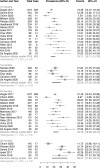Rhythm monitoring strategies for atrial fibrillation detection in patients with cryptogenic stroke: A systematic review and meta-analysis
- PMID: 33948484
- PMCID: PMC8080458
- DOI: 10.1016/j.ijcha.2021.100780
Rhythm monitoring strategies for atrial fibrillation detection in patients with cryptogenic stroke: A systematic review and meta-analysis
Abstract
Objective: To summarize data on atrial fibrillation (AF) detection rates and predictors across different rhythm monitoring strategies in patients with cryptogenic stroke (CS) or embolic stroke of undetermined source (ESUS).
Methods: MEDLINE, Embase, and Web of Science were searched to identify all published studies providing relevant data through July 6, 2020. Random-effects meta-analysis method was used to pool estimates.
Results: We included 47 studies reporting on a pooled population of 8,215 patients with CS or ESUS. Using implantable cardiac monitor (ICM), the pooled rate of AF was 12.2% (95% CI 9.4-15.0) at 3 months, 16.0% (95% CI 13.2-18.8) at 6 months, 18.7% (95% CI 15.7-21.7) at 12 months, 22.8% (95% CI 19.1-26.5) at 24 months, and 28.5% (95% CI 17.6-39.3) at 36 months. AF rates were significantly higher in patients with ESUS vs CS (22.0% vs 14.2%; p < 0.001) at 6 months, and in studies using Reveal LINQ vs Reveal XT ICM (19.1% vs 13.0%; p = 0.001) at 12 months. Using mobile cardiac outpatient telemetry (MCOT), the pooled rate of AF was 13.7% (95% CI 10.2-17.2) at 1 month. Predictors of AF detection with ICM included older age, CHA2DS2-VASc score, left atrial enlargement, P wave maximal duration and prolonged PR interval.
Conclusion: The yield of ICM increases with the duration of monitoring. More than a quarter of patients with CS or ESUS will be diagnosed with AF during follow-up. About one in seven patients had AF detected within a month of MCOT, suggesting that a non-invasive rhythm monitoring strategy should be considered before invasive monitoring.
Keywords: Atrial fibrillation; Cryptogenic stroke; Embolic stroke of undetermined source; Holter; Insertable cardiac monitor; Telemetry.
© 2021 The Authors.
Conflict of interest statement
Dr. Sanders reports having served on the advisory board of Medtronic, Abbott Medical, Boston Scientific, CathRx and PaceMate. Dr. Sanders reports that the University of Adelaide has received on his behalf research funding, lecture and/or consulting fees from Medtronic, Abbott Medical, Boston Scientific and Microport. All other authors report no disclosures.
Figures





Comment in
-
Searching for atrial fibrillation post-stroke with prolonged monitoring: Do it early, but should we be looking for something else?Int J Cardiol Heart Vasc. 2021 Jun 9;34:100819. doi: 10.1016/j.ijcha.2021.100819. eCollection 2021 Jun. Int J Cardiol Heart Vasc. 2021. PMID: 34169143 Free PMC article. No abstract available.
References
-
- Schnabel R.B., Haeusler K.G., Healey J.S., Freedman B., Boriani G., Brachmann J. Searching for Atrial Fibrillation Poststroke A White Paper of the AF-SCREEN International Collaboration. Circulation. 2019;140(22):1834–1850. - PubMed
-
- Kaarisalo M.M., Immonen-Räihä P., Marttila R.J., Salomaa V., Kaarsalo E., Salmi K. Atrial fibrillation and stroke. Mortality and causes of death after the first acute ischemic stroke. Stroke. 1997;28(2):311–315. - PubMed
LinkOut - more resources
Full Text Sources
Other Literature Sources
Research Materials

